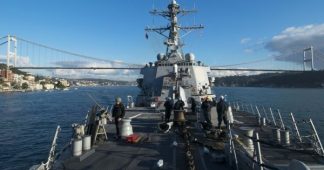Navy Deploys Destroyers To Black Sea To “Desensitize” Russia To US Presence
by Tyler Durden
Wed, 02/21/201
With US relations with Russia once again deteriorating by the day, the Navy has deployed the Arleigh Burke-class guided-missile destroyer USS Carney to the Black Sea, where it will join the destroyer USS Ross, in a move that military officials told CNN is intended to “desensitize Russia” to the presence of US military forces in the Black Sea, Russia’s geographic equivalent of the Gulf of Mexico.
Officials told CNN that given the heightened tensions and increased military activity in the region “it is important to increase the frequency of US activity in the area and desensitize Russia to the presence of US military forces there”, helping to establish rules for how the two countries should safely operate in proximity to each other, as they did in the Cold War.
In the Cold War we had a dance we did and everybody knew their roles in the dance: You fly your bomber here, I’ll fly my bomber there. You put a ship here, I’ll put a ship there,” another US defense official in Europe told CNN.
“I don’t think we’ve got to that level yet, and so we’re still trying to figure out what that dance looks like in the year 2018 versus what it was back in the Cold War, and I think there are some growing pains, obviously,” the official added.
The deployment of the USS Carney marks the first time in four years that two American destroyers have operated in the Black Sea outside of scheduled exercises, according to the Military Times which adds that “the last time the U.S. sent a multi-destroyer security patrol to the Black Sea was during the 2014 Sochi Winter Olympics, shortly before the Crimea annexation.” Since then, multiple U.S. warships have been on location in the Black Sea but always in the context of a naval drill, including a recent trip for the annual Sea Breeze exercise.
The naval deployment comes as NATO ground forces pile up in central and eastern Europe, allegedly in response for Russia’s continued militarization of Crimea. Nevertheless, U.S. and NATO officials have insisted that they are not playing tit-for-tat with the Russians.
“Our decision to have two ships simultaneously operate in the Black Sea is proactive, not reactive,” said Vice Adm. Christopher Grady, commander of 6th Fleet, which oversees U.S. naval operations in the region. “The continued presence of the U.S. Navy in the Black Sea demonstrates our enduring commitment to regional stability, maritime security of our Black Sea partners, and the collective defense of our NATO allies,” he added
#USSCarney?? transited #Bosphorus?? to join #USSRoss for routine maritime security operations IAW int'l law. C6F Commander VADM Grady assured: "Decision to have 2 ships in #BlackSea is proactive not reactive & demonstrates our commitment to regional stability" #SteadyPresence pic.twitter.com/f1q1KfObk0
— Naval Forces Europe (@USNavyEurope) February 17, 2018
On Sunday Russia announced its own naval deployments to the area, with the Russian Ministry of Defense issuing a statement saying that a Russian frigate, the Admiral Essen, and two patrol ships had entered the Black Sea for a series of exercises.
A US defense official based in Europe told CNN that the Russians “are very sensitive to our precision strike capability” as well as US ballistic missile defense assets such as the Aegis Ballistic Missile Defense System, which is deployed on both the Ross and Carney.
“You get ships up in the Black Sea, that makes them feel more threatened,” the official added.
Officials say that same Russian sensitivity explains why Russian aircraft have appeared to perform more unsafe intercepts of US surveillance aircraft in the area than they do in other areas.
US officials say the surveillance flights are necessary to better understand Russian military activity.
“Russia is also not particularly transparent in what they do, which obviously requires us to then be able to monitor them by other means, and reconnaissance is one of those means,” one defense official said.
The Black Sea – Russia’s main naval gateway into the Mediterranean – sits between Eastern Europe, the Caucasus and Western Asia, and is bordered by several NATO nations.
It has long been a contentious region for U.S. and Russian military forces, but tensions spiked after the military escalation in Ukraine in 2014. Since then, there have been several skirmishes between Russian forces looking to assert their ownership of the region and U.S. forces asserting their right to operate in international waters and airspace.
The destroyers Carney and Ross are both equipped with the Aegis Ballistic Missile Defense System, which a U.S. defense official told CNN the Russians are especially sensitive to. Both U.S. ships are forward deployed to Naval Station Rota, Spain, and regularly patrol the Mediterranean and the Black Sea.











